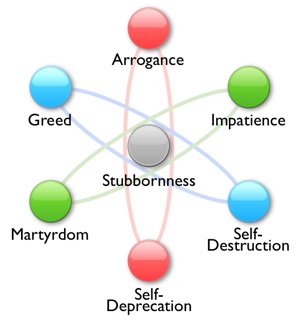
STUBBORNNESS is one of seven basic character flaws or “dark” personality traits. We all have the potential for stubborn tendencies, but in people with a strong fear of change, Stubbornness can become a dominant pattern. Stubbornness is a personality trait in which a person refuses to change their opinion about something or refuses to change their mind about a decision that they’ve made. Stubborn people have a resolute adherence to their own ideas and opinions. A stubborn person has the “No I won’t, and you can’t make me” attitude.

Virtual Tour ↗
Get a virtual tour of the museum. Ideal for schools and events.
Current Shows ↗
Stay updated and see our current exhibitions here.
Useful Info ↗
Get to know our opening times, ticket prices and discounts.
Stubbornness is a basic character flaw or personality defect, one of seven possible chief features adopted in adolescence to protect the self at the level of false personality.
Stubbornness is the tendency to resist any form of change. It is defined as:
refusing to move or change one’s opinion; [1]
the trait of being difficult to handle or overcome; resolute adherence to your own ideas or desires [2]
Other names for stubbornness include dogged insistence, intransigence, temerity and pig-headedness.
Stubbornness is essentially an entrenched resistance to change. And given that life is all about change, stubbornness is effectively a resistance to life itself.
The person with stubbornness is driven by a fundamental resistance to being forced to do anything or experience anything against his will. The basic stance is, “No, I won’t, and you can’t make me.”
The personality with stubbornness is over-sensitive to the possibility of having sudden or unwanted change imposed upon itself, and sees the threat of it everywhere. Anything new or different or involving change is perceived (subconsciously at least) as a direct threat—even if the change in question is positive and in the person’s best interests.
Like all character flaws, stubbornness involves the following components:
- Early negative experiences
- Misconceptions about the nature of self, life or others
- A constant fear and sense of insecurity
- A maladaptive strategy to protect the self
- A persona to hide all of the above in adulthood
Stubbornness and identity
Stubborn people are rigidly attached to their beliefs, opinions, ideas, and tastes. They can’t stand anyone disagreeing with them because disagreeing with them means disagreeing with who they are.
They become stubborn to the point that they don’t even consider the opinion of others because they feel threatened by people who disagree with them.
So, in a way, this is also a type of pain-avoidance. This kind of stubbornness can hamper the growth of a person and badly affect their relationships with people. Some go a step further by totally avoiding people who don’t agree with them just so they can live in the world of their own ideas and opinions.
Early Negative Experiences
In the case of stubbornness, the early negative experiences typically consist of domestic instability or upheaval and the streess of having to suddenly put up with new situations. The situations causing such stress could be beyond the parents’ control, such as having to uproot in a time of war.
Alternatively, the stressful instability (as the child experiences it) could be of the parents’ own choosing, such as constantly moving home to find a better job. Most often, perhaps, it is just part of ordinary family life—the arrival of a new baby, for instance.
Whatever the circumstances, the core experience for the child in question is the shock of the new. Just when the child thought she knew where she was, living safely at home with her best friends and her favourite toys, without any warning she is whisked off to start afresh in a new, unfamiliar place. Change has been imposed against her will, and it has caused unbearable stress.
The cumulative effect is a desparate desire for stability and familiarity, to stay put and have everything nailed into place, and to fend off anything new or unfamiliar.
Misconceptions
From such experiences of sudden instability and imposed change, the child comes to perceive life as being unstable and volatile:
New situations are traumatic and must be avoided.
People want to impose drastic changes on me against my will.
A big enough change in my life could destroy me.
Fear
Based on the above misconceptions and early negative experiences, the child becomes gripped by a specific kind of fear. In this case, of course, the fear is of new situations—of having new, unfamiliar circumstances imposed upon oneself.

Strategy
Because of this constant fear, the individual will crave permanance, stability and predictability. So the basic coping strategy is to resist change and any possibilty of change.
Typically this involves:
- refusing to change or to accept new situations when asked to do so;
- blocking the emergence of new/unfamiliar situations;
- perceiving and anticipating every possibility of change or novelty so that it can be blocked;
- denying that there is ever a need for change;
- resisting internal pressures or impulses to change oneself.
In the case of illness, for example —
The chief feature of stubbornness will often insist nothing is wrong in the first place, no matter what evidence there is to the contrary, but once illness has occurred, it then strives to continue the pattern so that nothing so dangerous as new improvement is permitted.
MICHAEL
Persona
Finally, emerging into adulthood, the individual does not want go around being overtly afraid of new situations. Hence stubbornness puts on a mask which says to the world, “It’s not me—it’s just this situation. Changing it would be wrong and unnecessary. Everything is fine the way it is, actually.”
Under the guise of reasonableness and logic, the underlying fear tries to have its way. All new ideas are supposedly unreasonable and illogical. All actual changes are unnecessary and bad.
When this doesn’t work, however, the mask comes off and the underlying shadow or “inner demon” is likely to emerge in a fit of rage. “How dare you do this to me? It’s totally outrageous!” The rage is driven by a deep inner sense of overwhelming panic over the new situation.
All people are capable of this kind of behaviour. When it dominates the personality, however, one is said to have a chief feature of stubbornness.
Positive and Negative Poles
In the case of stubbornness, the positive pole can be termed DETERMINATION and the negative pole can be termed OBSTINACY.
+ determination +
|
STUBBORNNESS
|
– obstinacy –
Determination is state of mind that ensures a good enough situation is maintained: It ought to be this way because it makes sense. In moderation, this can be healthy or at least a healthy antidote to any kind of victim state.
Obstinacy, however, is a state of excessive fixation on an existing situation, regardless of logic, regardless of desirability. It must be this way because I say so and I don’t care what anyone masteron enanthate pre-competition considerations else says. Obstinacy will cause a person to cling to a terrible situation for no reason other than to avoid the possibility of facing change.
Handling Stubbornness
Stubbornness is the most prevalent character flaw there is. We all have some degree of stubbornness withion us, but more people have stubbornness as their chief feature than any other.
As with every chief feature, the key is becoming conscious of how stubbornness operates in oneself. If you have stubbornness, you can begin by observing your outward persona in action:
- Do I have a tendency to justify the status quo?
- Do I generally argue against change or newness on seemingly logical grounds?
- Do I often deride new ideas or suggestions?
Try to catch yourself in the act of putting on your “Leave well alone!” mask.
Then dig deeper:
- Why do I resist change, newness? What am I afraid of?
- What do I fear would happen to me if I allowed uncontrollable chnges to happen?
Approaching the deepest level you may need outside help in the form of a counsellor, therapist or at least a close friend:
- Where does this fear of new situations come from?
- How was I hurt in the past?
- Can I let it go?
Just as you can become more aware of stubbornness through self-observation and self-enquiry, so too you can gain more control over it through using that awareness and by exercising choice in the moment.
- Whenever I am tempted to resist or attack people who want to change the status quo, I will consider the unreasonableness of my intentions rather than just theirs.
- I understand that resistance to change is a resistance to life itself and leads nowhere.
- I will be more willing to allow ordinary changes to happen in my life, knowing that they won’t destroy me.
Another way to handle a chief feature is to “slide” to the positive pole of its opposite. In the case of stubbornness, though, there is no opposite. It is the only neutral form of chief feature—which means it has no polar opposite, being positioned at the intersection of all the dualities.
This allows for greater flexibility, however. A person with stubbornness can easily “slide” from neutral into any of the other chief feature positions, such as greed or martyrdom.
If you are getting caught in the grip of stubbornness’s negative pole of obstinacy, you can re-balance yourself using the positive pole of any of the six other defensive patterns:
- desire (the positive pole of greed)
- sacrifice (the positive pole of self-destruction)
- pride (the positive pole of arrogance)
- humility (the positive pole of self-deprecation)
- audacity (the positive pole of impatience)
- selflessness (the positive pole of martyrdom)
In each case, there is a determination to cause, or allow, things to change—and determination is the positive pole of stubbornness.
For example, when you are stuck in obstinacy, sitting with “I won’t allow it! I won’t allow it!”, your attention is wrapped up in the imposition of change and your sole intention is to resist that. To loosen the grip of stubbornness you have to you turn your attention to some other aspect of the situation:
- What’s in it for me? (desire)
- Even though I don’t like it, will it help someone I care about? (sacrifice)
- Will it make me feel better about myself? (pride)
- Will it help bring my ego down to earth? (humility)
- Will it buy me time to do what I really want to do? (audacity)
- Is it just what’s needed, regardless of what I want? (selflessness)
By paying attention to one of these aspects of the situation, your fixation on the change itself is loosened. And by being willing to go with one of these aspects, your intention to resist is overcome.
At Positive Psychology and Educational Consult, we are ready to help you to navigate your life. Contact us today. We are available online 24/7. Phone: +2348034105253. Email: positivepsychologyorgng@gmail.com twitter: @positiv92592869. facebook: positive.psych.12
Further Reading
Or for an excellent book about the chief features (character flaws) and how to handle them, see Transforming Your Dragons by José Stevens.
Also of interest: Mirror mirror on the wall, who is the stubbornest of them all? (A Colorful Mind blog)

One Reply to “Stubbornness: The Fourth Chief Feature of Ego”